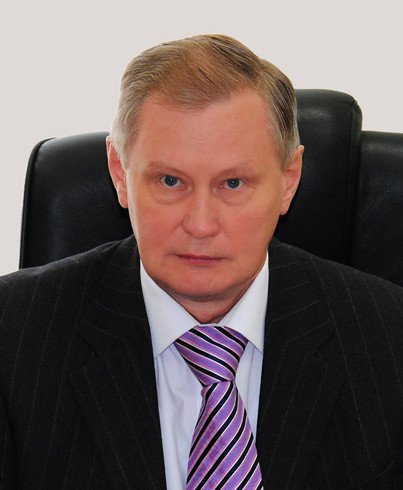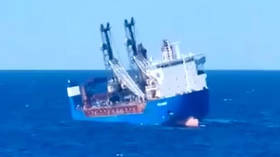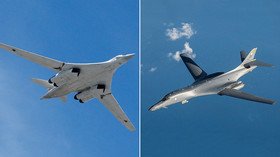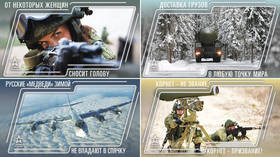‘Prepared to counter any threat’: Russia’s top 10 military events of 2018

The outgoing year of 2018 was marked by large-scale maneuvers, military exercises, launches and advances in terms of military equipment. Military analyst Mikhail Khodarenok has outlined top 10 events.
Russia’s Ministry of Defense managed to keep up the high standard of national defense potential in 2018, despite all the challenges related to budgetary restrictions. Compared to 2017, the key indicators in the development of Russia’s Army and Navy are showing growth, however modest.
Top officials at the Defense Ministry estimate that the Russian Armed Forces are currently combat-ready, and the government didn’t have to build up sheer manpower or increase defense spending to achieve this. The military is sure they are prepared to counter any threat, existing or hypothetical. One of the most impressive things about modern-day Russian army is that 96% of regiment and brigade commanders have actual combat experience. This is something one cannot buy with money or even develop in full by staging military exercises. Combat experience can only be acquired at war, under enemy fire.
READ MORE: Spot on: Russia to track future US missiles with upgraded over-the-horizon radar
It is noteworthy that Russia’s 2018 Defense Budget was 13.4 times smaller than that of the United States and comprised just 2.9% of the country’s GDP (there is a 0.5% drop compared to the 2017 defense spending). In the US, military expenditures amounted to 14.7% of the federal budget and 3% of GDP.
This means that in 2018 Russia managed to achieve considerable progress in the military sector in spite of the cuts in the defense budget.
Below are the 10 most impressive results accomplished by the Russian Defense Ministry in the outgoing year, in this author’s opinion.
Vostok-2018 exercise
The Vostok-2018 exercise was the biggest military drill in Russia’s modern history. The international status of the event was marked by the participation of military units from the Chinese People’s Liberation Army and the Mongolian Armed Forces. With respect to manpower and the sheer number of weapons and military hardware involved, the exercise can be compared to the Zapad-1981 maneuvers, while in terms of territory covered and the scope and scale of troop repositioning, the event is unrivaled by any military exercise conducted during the Soviet era. The centerpiece of the war games has held at Tsugol training ground in Russia's Zabaikalsky Territory. It included over 25,000 soldiers and officers, more than 4,960 pieces of military equipment, including 130 aircraft and helicopters, 10 unmanned aerial vehicles, nine units of the 29th, 35th, and 36th armies of the Eastern Military District, a brigade and a tank regiment of the Central Military District, two air assault brigades of the Russian Airborne Troops, a brigade of the People’s Liberation Army of China and a platoon of the Mongolian People's Republic.
Drills in Mediterranean Sea
In 2018, the Russian Navy held its first major naval exercise in the eastern part of the Mediterranean Sea. A naval force consisting of 28 warships and auxiliary vessels, as well as 36 naval aviation units, have demonstrated their ability to efficiently accomplish all the missions assigned to them, and have showcased that they are well-prepared to protect Russia’s national interests in the Mediterranean Sea. The exercises involved ships from almost all fleets in the Russian Navy: the Baltic Fleet, the Black Sea Fleet, the Northern Fleet, and the Caspian Flotilla. The maneuvers were spearheaded by the guided missile cruiser Marshal Ustinov of the Northern Fleet. The naval units were joined by the Tu-160 strategic bombers, the Tu-142, and Il-38 anti-submarine aircraft, as well as Su-33 fighter jets and Su-30SM fighters of the Russian Naval Air Force. The purpose of the exercise was to practice anti-submarine and anti-aircraft warfare, as well as the defense of maritime communications, anti-piracy operations and assistance to vessels in distress. The drill also included test missile launches and artillery exercises.
Russian submarine test-launches 4 Bulava ballistic missiles
Russia’s Project 955 Borei-class strategic nuclear submarine Yuri Dolgoruky has successfully test-fired four R-30 Bulava intercontinental ballistic missiles from the White Sea to hit designated targets at the Kura range in the Far Eastern Kamchatka region. It was the first-ever salvo fire carried out by this type of submarine. The test confirmed combat readiness of the Project-955 Borei-class strategic submarine and the Bulava missile system. The R-30 Bulava-30 ballistic missile can deliver 6-10 nuclear MIRV warheads to a distance of 8,000 km.
Test-fire of Kh-101 air-launched cruise missiles
In November, the successfully modernized Tu-160 strategic bomber test-fired twelve Kh-101 air-launched cruise missiles at the Pemboi range in Russia’s Komi Republic, to the north of the Polar Circle. If one were to use the Kh-102 model (which carries a nuclear payload), the resulting strike would be enough to annihilate a small country of up to 10 thousand square kilometers.
Kinzhal hypersonic missile
The Kinzhal high-precision hypersonic missile is ready for experimental and combat duty missions. Russian aircraft equipped with the Kinzhal system have completed 89 patrol flights in the Black and Caspian Seas. Russia has become the first country to successfully test hypersonic weapons and put them on combat duty, which raises the country's defense and strike capabilities to a new high. Kinzhal's maximum flight speed is 12,250 km/h, with an operational range of 2,000 km. The hypersonic missile takes less than 10 minutes to cover this distance.
Peresvet combat lasers enter duty
Starting December 1, 2018, Russian-made Peresvet combat laser systems have started to enter duty with the Russian Armed Forces. The Peresvet laser system has a broad range of applications and is able to hit almost any air target, which boosts Russia's capabilities of defending itself and its national interests.
Also on rt.com WATCH Peresvet combat laser system enter test duty in Russia (VIDEO)Sarmat ICBM successfully pass pop-up tests
In 2018, the Sarmat intercontinental ballistic missile successfully passed pop-up launch tests. The RS-28 Sarmat is a liquid-fueled, MIRV equipped, superheavy thermonuclear armed intercontinental ballistic missile system. The unit's weight is over 200 tons, with a range that allows it to target any location on the globe. The missile payload allows for more than 10 MIRV warheads.
Upgraded Borei-Class ballistic missile sub enters sea trials
Russia started testing of Knyaz Vladimir (Prince Vladimir), the new Borei-A submarine that is notable for its improved stealth system and exceptional reliability, compared to its foreign counterparts. The Sevmash Shipyard in Severodvinsk in northwest Russia has already produced three Borei-class Project 955 submarines: the lead submarine Yuri Dolgoruky is on duty with the Northern Fleet, while the serial-produced Alexander Nevsky and Vladimir Monomakh are operational in the submarine forces of the Pacific Fleet.
Also on rt.com Sea trials of upgraded Borei-class nuclear submarine reportedly underway in RussiaIncrease in military hardware
The share of modern weapons and military equipment is now up to 82% in Russia's strategic nuclear forces, 48.3% in the Ground Forces, 74% in the Aerospace Force, 62.3% in the Navy, and 63.7% in the Airborne Troops.
12,000 officers join Armed Forces
Russia has successfully restored its military education system, as the first full-fledged graduation ceremony took place at higher education institutions of the Russian Ministry of Defense. Over 12,000 new officers have been assigned to their new positions within the Russian Armed Forces, all in accordance with their qualifications. In 2018, there were up to 8 applications per every first-year undergraduate position at the Ministry of Defense institutions, with as much as 20 people per position in some schools.
What to expect in 2019
As for the 2019 defense budget, the details are as follows. The Russian Ministry of Defense budget will be 15 times less than the US military spending. It will account for 17.0% of the country's complete budget (a decrease of 0.3% compared to 2018) and will remain at 2.9% of the GDP.
The most anticipated military landmark of the upcoming year is the deployment of the first Russian Strategic Missile Forces regiment armed with the new Avangard hypersonic boost-glide warhead. The new missile will be able to cover the distance to the target by flying through the upper layers of the atmosphere at a hypersonic speed exceeding Mach 20, and maneuver to avoid anti-missile defenses.
As for the problem areas and the unresolved issues (which obviously still exist both in the Russian Army and in the Navy), according to military officials, they will be factored into the 2019-2025 Military Program of the Russian Defense Ministry. One of the major challenges related to the State Defense Order is its low profitability. The State Defense Order is perceived as a heavy economic burden by most defense enterprises. The Russian Defense Ministry is facing a somewhat ironic conundrum – the State Defense Order, which in most countries is a prize aggressively sought after by most military enterprises, has turned unprofitable in the eyes of Russia's domestic defense companies. Unless assertive measures are taken to remedy the situation, Russia could face a sharp decline in its military-industrial sector.
Think your friends would be interested? Share this story!
The statements, views and opinions expressed in this column are solely those of the author and do not necessarily represent those of RT.
















